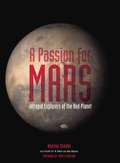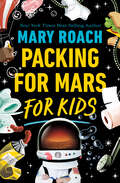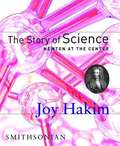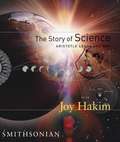Résultats de recherche de titre
Articles 1 à 20 sur 169

Physics in the 20th century
Par Curt Suplee, Judy R Franz, John S Rigden. 1999
Describes advances in physics over the last century. Includes chapters on the electromagnetic spectrum, quantum mechanics, atomic structures, chaos and…
order, and the evolution of the universe. Chronicles the research that resulted in the creation of new technology. Senior High and older. c1999.
How did we find out about the speed of light? (How did we find out--series.)
Par Isaac Asimov. 1986

The mysterious rays: Marie Curie's world (Science Discovery Book Ser.)
Par Victor Juhasz, Nancy Veglahn. 1977

Astrophysics for young people in a hurry
Par Gregory Mone, Neil DeGrasse Tyson. 2019

A passion for Mars: intrepid explorers of the Red Planet
Par Andrew Chaikin, Andrew Chaiken. 2008
Science journalist and author of A Man on the Moon (RC 39809) profiles individuals--astronomer Carl Sagan, rocket physicist Wernher von…
Braun, and others--whose vision, passion, and scientific achievements have brought a deeper understanding of Mars. Chronicles space programs and Martian fascination since the mid-twentieth century. Foreword by James Cameron. 2008
The motion paradox: the 2,500-year-old puzzle behind all the mysteries of time and space
Par Joseph Mazur. 2007
Mathematics professor ponders Greek philosopher Zeno's four paradoxes, which raise fundamental questions about the mechanisms of the universe and which…
conclude that motion is an illusion. Examines scientific advances--such as calculus, relativity, and quantum mechanics--that have increased understanding of material reality but have not necessarily solved Zeno's conundrum. 2007
Physics projects for young scientists (Projects for Young Scientists Ser.Projects for Young Scientists Series)
Par Richard C Adams, Richard C. Adams, Peter Goodwin. 2000
Explains how to conduct simple experiments exploring the science of physics. Projects address the study of mechanics; temperature and pressure;…
properties of matter; vibrations, electricity, and magnetism; and building an ammeter. For grades 6-9. 2000
Science projects about physics in the home (Science projects)
Par Robert Gardner. 1999
Describes twenty-six experiments relating to the study of matter and energy. Suggests an appropriate site for each procedure, such as…
a living room, bedroom, kitchen, bathroom, or playground. Projects include finding your center of gravity, demonstrating Newton's third law in your bathtub, and vibrating rulers and strings. For grades 6-9. 1999
Solids, liquids, gases, and plasma
Par David A Adler, David A. Adler, Anna Raff. 2019

Packing for Mars for kids
Par Mary Roach. 2022
"What is it like to float weightlessly in the air? What happens if you vomit in your helmet during a…
spacewalk? How do astronauts go to the bathroom? Is it true that they don't shower? Can farts really be deadly in space? Best-selling Mary Roach has the answers. In this whip-smart, funny, and informative young readers adaptation of her best-selling Packing for Mars, Roach guides us through the irresistibly strange, frequently gross, and awe-inspiring realm of space travel and life without gravity. From flying on NASA's Weightless Wonder to eating space food, Packing for Mars for Kids is chock-full of first-hand experiences and thorough research. Roach has crafted an authoritative and accessible book that is perfectly pitched to inquiring middle grade readers." -- Provided by publisher
What's so bad about gasoline?: fossil fuels and what they do (Let's-read-and-find-out Science 2 Ser.)
Par Anne F Rockwell. 2009
Discusses the history of petroleum use as fuel and the environmental problems caused by gasoline engines in cars and trucks.…
Explains ways to reduce pollution and suggests alternative sources of energy. For grades 2-4. 2009
Examines Albert Einstein's discoveries in the quantum world, the theory of relativity, and nuclear physics. Discusses the way his theories…
revolutionized scientific thinking about the universe and led to modern inventions, from the atom bomb to cell phones. For grades 6-9 and older readers. 2007
Apollo 11: first men on the moon (Pocket space guide)
Par Robert Godwin. 2005
Provides a concise history of humankind's exploration of the Moon--from Greek astronomy to manned space flight. Profiles the three astronauts…
who traveled aboard Apollo 11 and chronicles their 1969 mission. Describes the scientific experiments conducted by the crew and their equipment. For grades 6-9. 2005
Kids to space: a space traveler's guide
Par Lonnie Jones Schorer. 2006
Students aged three to eighteen ask questions about planning a trip to the moon or a future orbiting hotel. More…
than eighty experts provide the answers on traveling and living in outer space. Covers astronauts, space exploration, and going into space with disabilities. For grades 5-8 and older readers. 2006
Newton at the center: the story of science (The Story of Science #2)
Par Joy Hakim. 2005
Discusses the scientists, arguments, and breakthroughs of the Scientific Revolution that occurred between the sixteenth and nineteenth centuries. Explains the…
development of ideas from the tradition of Greek philosophy to the scientific method of observation and experimentation, which spurred discoveries like Isaac Newton's theory of gravity. For grades 5-8. 2005
Aristotle leads the way: Aristotle Leads the Way (The Story of Science #1)
Par Joy Hakim. 2004
Introduces the forefathers of modern science and the discoveries they made in astronomy, math, and physics. Proceeds from creation myths…
to the four elements, geometric principles, ancient cities of learning, and Earth's place in the universe. For grades 5-8 and older readers. 2004
Are we alone?: scientists search for life in space
Par Gloria Skurzynski. 2004
Discusses the possibilities of identifying and communicating with another life-form in our vast universe. Describes the interconnectedness of research in…
many scientific disciplines to investigate hospitable planets. Includes profiles of scientists dedicated to seeking extraterrestrial intelligence. For grades 5-8. 2004
What is the world made of?: all about solids, liquids, and gases (Let's-read-and-find-out Science 2 Ser. #1)
Par Kathleen Weidner Zoehfeld. 1998

La fission de l'atome (Les grandes découvertes scientifiques)
Par Alan Q Morton. 2006
Ce livre vous renseignera sur la fission de l'atome réalisée dans les années 1930. La fission de l'atome examine les…
théories et les réalisations pratiques qui ont mené à ce tournant majeur de la science nucléaire: le moment ou on a constaté que la fission du noyau d'un atome produisait une énergie qu'il était possible de domestiquer, pour le bien et pour le mal. L'ouvrage explique la structure de l'atome, les progrès qui ont permis de découvrir la fission et tous les incidents de parcours jusqu'au largage de la première bombe nucléaire en 1945. Il présente aussi les gens qui ont le plus contribué à cet événement décisif et examine son influence sur la physique atomique et sur la vie quotidienne des gens jusqu'à ce jour. -- 4e de couv
Galilée et Einstein: petite conférence sur la science (Les petites conférences)
Par Françoise Balibar. 2006
Souvent les problèmes de la physique rejoignent le réel le plus immédiat. Le mouvement, par exemple, qui intrigue les hommes…
depuis toujours. La pierre qui tombe au pied du mat d'un bateau qui se déplace, l'impression de mouvement qu'on a dans un train à l'arrêt lorsque le train d'à côté démarre, et ainsi de suite... De petites choses, de petits décalages, mais à partir desquels s'ouvre toute la complexité du réel et ce que l'on allait appeler la relativité. En 1610, Galilée pointe sa lunette vers le ciel; à 26 ans, Einstein révolutionne la physique. C'est le parcours de ces deux hommes que retrace ici Françoise Balibar, deux très grands physiciens, deux hommes pris dans les combats de leur temps aussi. -- 4e de couv